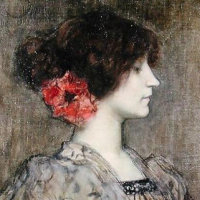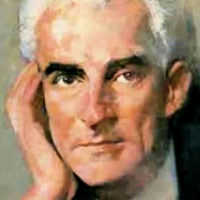11. A Magical Morality Tale.
“The Child and the Enchantments,” “The Boy Bewitched,” or simply “Homework”—people usually give up trying to
translate the title and stick with the French: L’enfant et les sortilèges. Maurice Ravel’s one-act opera
of 1925 is like nothing else in the repertory. A naughty child refuses to do his homework, and his mother locks him
into the room as punishment. He goes wild and trashes everything in sight. Whereupon all the objects that he
has damaged—furniture, a grandfather clock, a teapot and cup, the torn wallpaper—come to life to teach him a
lesson, some by attacking him physically, some by making him feel regret. He escapes to the garden, but there
the trees and insects are joined by the small animals he has harmed. All until he shows real compassion by
binding up the paw of an injured squirrel. The animals realize there is good in him after all, and return him
to his mother. Ravel responds to the inventive and always poetic libretto of Colette (the author of Gigi)
with music that ranges from 18th-century dance to American jazz, and astonishing strokes of orchestral color.
The many different episodes in the opera obviously preclude realism. But what is a stage-director’s challenge is
also a stage-director’s opportunity. The many videos out there show a wider range of concept than you could
find in most operas. After the break, we shall watch one such staging complete: Laurent Pelly’s handsome 2012
production from Glyndebourne, a house renowned for the elegance of its physical presentations. But L’enfant
does not require a large budget; one of my own productions was given in a black box by dancing singers in leotards,
and it may well have been the best. And the show doesn’t even require an opera stage. The clips we shall sample
in the first hour to taste the many ingredients that go into this wonderful confection include a concert performance,
a film, a mix of live-action with cartoon, and a ballet danced to a pre-existing recording. It’s magic, after all;
anything is possible.
The script, videos, and images will be posted immediately after class.
VIDEO LINKS
The bad news is that the 2012 Glyndebourne production I showed after the break is available on YouTube only as
a trailer plus three excerpts. There is a DVD, but at $104 it is outrageously expensive. The good news is that
many of the other productions from which I took my clips for the first hour are indeed available complete,
although mainly without English titles. The first link to each of these below is to the complete performance;
the remainder are to the excerpt(s) watched in class. There is also a beautiful introduction to his ballet by
Jiri Kylian.
I also include some links to individual clips from other sources. These include several other scenes from the
2019 production in Lyon, with the projections on the front scrim. I also add one other complete production, from
Monte Carlo where it all began 100 years ago; although a poor quality video, it has a very interesting concept:
that all the characters are servants in the very upscale house where it all opens. The trailer from VOpera is
from a COVID-lockdown film; it will not tell you much, but it does show some more of the range that this
particular work seems to inspire! rb.
*Asterisks are to clips that we did not even sample in class. rb.
| GLYNDEBOURNE 2012 |
| |
Various clips |
|
* Trailer
* Fire scene
(Kathleen Kim)
* The Child's lament
(Khatouna Gadelia)
* Cats' scene
(Elliot Madore, Stéphanie d'Oustrac)
|
| OTHER COMPLETE PERFORMANCES |
| |
Film 1967 |
|
* Complete, no titles
* Child's tantrum
* Wallpaper scene
|
| |
Glyndebourne 1987 |
|
* Complete, English titles
(Maurice Sendak designs)
* Teapot/Teacup scene
|
| |
Nederlands DT 1988 |
|
* Intro by Jiri Kylian
(in English, very informative)
* Complete, no titles
(ballet by Jiri Kylian)
* English titles, poorer quality
(Italian titles, autotranslated)
* Ending sequence
(no titles, longer than in class)
|
| |
Lyon 1999 |
|
* Complete, French titles
* Section watched in class
|
| |
Concert 2021 |
|
* Complete, no titles
(Mikko Franck)
* Teapot/Teacup scene
* Garden scene opening
|
| OTHER CLIPS |
| |
Lyon 2019 |
|
* Trailer
* Compressed version
(opening, Princess, Cats, ending)
* Teapot/Teacup scene
* Arithmetic scene
* Squirrel and Frog
|
| |
Fire aria |
|
* Sabine Devieilhe
(different concert from above)
|
| |
Monte Carlo 2025 |
|
* Centennial production
(complete but poor video)
|
| |
VOpera |
|
* Trailer of COVID production
(offbeat, but interesting)
|
| |
|
|
|
|
|
| IMAGES |
| The thumbnails below cover the slides shown in class, plus a
few others that I threw in simply because I had them. Click the thumbnail to see a larger image.
Click on the right or left of the larger picture to go forward or back, or outside it to close. |
 | |
 | |
 | |
 | |
 | |
 | |
 | |
 | |
 | |
 | |
 | |
 | |
Here are brief bios of the composers and writers considered in the class, listed in order of birth.
 |
Colette, 1873–1954. French writer.
Sidonie-Gabrielle Colette published exclusively under her last name. Under the guidance of her first husband, the publisher Henry Gauthier-Villars (1859–1931), she began writing the four Claudette novels, which became popular. But the copyright reverted to him on their divorce in 1910, and she struggled for many years as an actress before emerging as France's most famous female writer. Internationally, her best-known works are the libretto for Ravel's L'enfant et les sortilèges (1925) and Gigi, which became the basis of the eponymous film and stage musical.
|
 |
Maurice Ravel, 1875–1937. French composer.
Though often grouped with Debussy as a musical Impressionist, Ravel was very much his own man. As a composer with a strong sense of tradition, he often wrote in older dance forms. As a virtuoso pianist, he wrote piano music of transcendent difficulty that extended the range of piano techniques. And as a master orchestrator, he enriched 20th-century music with some of its most vibrant colors.
|














